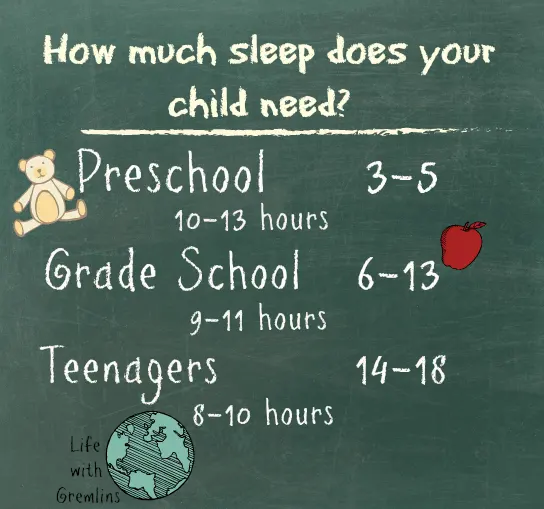
Start early.
Ideally, you should start trying to regain that school sleep schedule before school actually starts. If you slowly move bedtime back to an earlier hour and give wake-up calls earlier as well, the transition goes much smoother– less whining, less grumpy, more sanity. I’ve found shifting an hour each week works well. This also gives you an idea how soon you should start. Simply count how many hours you need to adjust bed time for school, and that’s the number of weeks lead you need.
Know how much sleep your child needs.
Not all kids need the same amount of sleep. If you’re trying to make your child sleep for too long, of course he or she will wake up earlier than necessary and then likely feel tired before bed time and nap– which messes everything up. Here are the average sleep requirements for school-aged children compliments of the National Sleep Foundation:
Also consider your child’s typical sleep habits previously in the summer if they were unregulated. Between the two, you should get a good idea of where to set bed times and wake-up times.
Be consistent.
Next, don’t allow a drastically different weekend sleep routine. While many parents let their kids stay up a bit later on the weekends, try to avoid all-nighters followed by mid-day snooze fests– unless there is a super awesome Doctor Who marathon or something, I mean who could deny a child that joy? A good rule of thumb is not to allow more than 4 hours bed time variance on the weekends.
Prepare your kids for sleep.
There are a few things that can make falling asleep harder on children, including:
-caffeine
-large meals
-snacks high in carbs or sugar
-high-energy activities
…pretty much all the stuff most kids love to sneak. Be sure that your daily schedule sets dinner time well before bed time, avoid desserts too close to bed time, and end the day in a relaxing, calm way. Younger kids really benefit from a routine of sorts as well. Keep it simple. Something like, we brush our teeth, read a book, go to bed. Elaborate routines of any kind are generally an epic fail because they are harder to keep up on. Letting your kiddo have some input on what your bed time routine consists of can also help encourage them to stick to it.
Use the light.
The brain relies on light to gauge when to go to bed and when to wake up, use that to your advantage. Start lowering light levels close to bedtime, eliminate as much light at bed time, and then provide bright light in the morning. On the dark side, black out curtains and low-light lamps or dim-able bulbs are a great start. For the sunshine, switch out your overhead lighting to daylight bulbs (this is also great for plants and beating the winter-time blues) and open those curtains up before your child wakes. Placing your child’s bed in a spot where when curtains are open, light lands on the bed (but not necessarily in their face) is also recommended.
Go to bed yourself.
You certainly don’t have to actually go to sleep, you can just hide in your room with a bottle of wine and your cookie stash if you want, but if there are people about the house being active, your child is less likely to go to sleep. Younger kids in particular worry they are missing something after they go to bed. It can be helpful to retreat to your room with the door shut, so it’s “bed time” for everyone, until your child falls asleep. This is less important of, of course, in older kids.
Have any tips on getting kids on a sleep schedule we missed? Something work well at your house? We’d love to hear your thoughts in the comments.
You might also find these helpful tips for achieving an easier wake-up call helpful.



